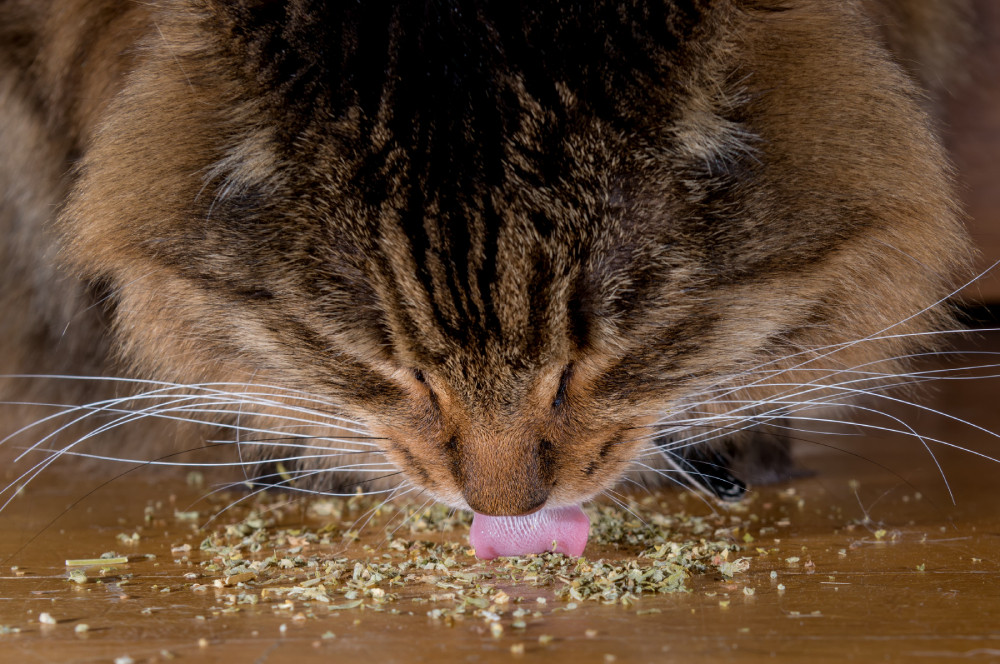Worried about your cat nibbling on your mint plants? You’re not alone. Many cat owners wonder, “Is Mint Bad For Cats?” It’s a valid concern, especially since cats are known for their curiosity and tendency to explore plants. The good news is that while some forms of mint can be harmful to cats, it’s not always a cause for panic.
If you’ve landed here searching for answers about mint and cat safety, rest assured, we’re here to provide clarity. While concentrated mint essential oils pose a real threat, the occasional nibble of garden mint is less likely to cause severe issues. This article, reviewed and fact-checked by a veterinarian, will delve into the nuances of mint and its effects on cats, helping you understand the real risks and how to keep your feline friend safe.
We’ll explore the different types of mint, their potential toxicity, the symptoms of mint poisoning in cats, and what to do if you suspect your cat has ingested a harmful amount. We’ll also clarify the often-confusing topic of catnip and catmint and their relationship to true mint. Let’s unravel the complexities and determine if mint is truly bad for cats.
Understanding the Mint Family: Genus Mentha
Mint plants belong to the genus Mentha, a diverse group within the Lamiaceae family, also known as the sage family. These plants are easily recognized by their characteristic square stems, elongated leaves, and, of course, their invigorating aroma. The refreshing coolness associated with mint comes from menthol, a chemical compound present in these plants.
Among the numerous varieties of mint, Mentha spicata, or spearmint (also referred to as garden mint, common mint, or lamb mint), is a prevalent species. It’s a hardy herb that can be found growing wild across a wide geographical range, from Ireland to China, and is commonly cultivated in gardens worldwide. In North America, Mentha canadensis, or American wild mint, is often found near water sources and in rocky, low-lying areas.
Spearmint (Mentha spicata) and peppermint (Mentha piperita) are both popular aromatic herbs within this family. Peppermint, another widely distributed mint, is also frequently used for flavoring and culinary purposes.
However, when discussing cats and mint, it’s crucial to distinguish between true mints and other members of the sage family that are often called “mint” but aren’t botanically the same. The most notable example is Nepeta cataria, commonly known as catnip, and Nepeta x faassenii, or catmint.
Catnip is famous for its ability to attract cats and stimulate playful behavior. It’s often used in cat toys and is known to induce a range of reactions in felines, from relaxation and mellowness when ingested to bursts of energy when sniffed. Catmint, while related to catnip, is another source of confusion regarding mint safety for cats, despite not being a true mint.
 Close up to Mint leaves in a pot
Close up to Mint leaves in a pot
Alt text: A close-up view of vibrant green mint leaves growing in a terracotta pot, showcasing the plant’s textured foliage.
The Risk of Mint Poisoning in Cats
The strong scents and flavors of mint plants are attributed to their essential oils. These concentrated oils are the primary culprits behind potential pet poisoning. Aromatherapy essential oils, being highly concentrated forms of these chemicals, are particularly dangerous for cats. Felines lack specific liver enzymes necessary to efficiently metabolize and eliminate these compounds, making them more susceptible to toxicity. Therefore, it’s advisable to avoid keeping essential oils, especially peppermint or Mentha piperita essential oils, in homes with cats.
It’s important to note that exposure to essential oils doesn’t require ingestion to be harmful. Inhalation through diffusers or absorption through the skin can also lead to intoxication in cats. If your cat exhibits any of the following symptoms and essential oils are present in your home, seek immediate veterinary attention as it constitutes a medical emergency.
Signs of Mint Essential Oil Poisoning in Cats:
- Excessive vomiting
- Drooling
- Uncoordinated or wobbly gait
- Difficulty breathing or rapid breathing
- Abnormally low body temperature
- Muscle tremors or twitching
- Decreased heart rate
While concentrated essential oils are a significant concern, the risk associated with cats nibbling on fresh mint leaves is considerably lower. Mint plants contain essential oils, but in their natural, undiluted form within leaves, the concentration is much less. A cat would need to consume a very large quantity of mint leaves to ingest a toxic dose of essential oil. Typically, cats might nibble at mint leaves but are unlikely to consume enough to cause severe poisoning.
However, even with fresh mint, ingestion can still cause gastrointestinal upset in cats. If your cat is showing signs of illness and you suspect they’ve been around your mint plants, be observant for these symptoms:
Signs of Mild Mint Intoxication from Ingesting Mint Leaves:
- Upset stomach or digestive discomfort
- Nausea or decreased appetite
- General weakness or lethargy
- Vomiting
- Diarrhea
If your cat displays these symptoms and they persist or worsen, especially after vomiting, it’s crucial to consult with your veterinarian.
💛 😺 Need Vet Advice Now? Speak to a Vet Online From the Comfort of Your Home!
 PangoVet
PangoVet
Alt text: PangoVet logo, an online veterinary service providing convenient pet advice.
For immediate veterinary guidance without leaving home, consider using PangoVet. This online service allows you to talk to a vet online and receive personalized advice for your pet at an affordable price.
Click to Speak With a Vet
Treating Mint Poisoning in Cats
If you suspect your cat has mint poisoning and take them to the vet, the veterinarian’s first step will be to assess your cat’s condition and the severity of the symptoms. Providing a detailed account of what your cat ingested is crucial. Information about the specific form of mint (essential oil vs. plant leaves), the species if known, and the estimated quantity ingested will be very helpful for the vet.
Depending on the situation, the vet may induce vomiting to remove mint from the cat’s system or perform gastric lavage (stomach pumping). Activated charcoal might be administered to absorb remaining toxins in the digestive tract. Gastric protectants and intravenous (IV) fluids may also be used to support your cat’s recovery.
In cases of essential oil intoxication, the vet might prescribe hepatoprotectants to support liver function, as essential oils are primarily metabolized by the liver. Hospitalization may be necessary for cats suffering from essential oil poisoning to provide intensive care and monitoring.
The Curious Case of Catnip
The discussion about mint and cats often becomes complicated with the inclusion of catnip and catmint. The name “catmint” itself can be misleading, leading people to mistakenly group it with potentially toxic mint varieties. However, as previously mentioned, catnip (Nepeta cataria) and catmint (Nepeta x faassenii) are not true mints but belong to the same sage family (Lamiaceae). But does this mean they are completely safe for cats?
According to the ASPCA’s toxic plants database, catnip/catmint is listed as potentially harmful to cats. The ASPCA notes, “Many cats love catnip, but it can cause vomiting and diarrhea. It makes some cats sedated and others stimulated.”
Cat reactions to catnip are varied and individual. Interestingly, around 30% of cats show no reaction to catnip at all. Other cats might exhibit behaviors like rolling, rubbing, and pawing at catnip, with the duration and intensity of the reaction varying. In cases of excessive ingestion, some cats may experience mild digestive upset.
So, what does this mean for cat owners? While catnip is generally considered harmless for most cats, it’s still wise to exercise moderation and avoid allowing excessive consumption. Instead of leaving catnip leaves readily available, it’s recommended to introduce catnip through safe toys. Toys typically contain a controlled amount of catnip, minimizing the risk of overindulgence and potential digestive issues.
It’s also important to be aware that sedation is a common effect of ingested catnip, which could potentially be confused with weakness associated with mint poisoning. Knowing your cat’s typical reaction to catnip is helpful. If they usually become hyperactive but suddenly appear lethargic after catnip exposure, it might warrant closer observation.
 Closeup of a cat eating catnip
Closeup of a cat eating catnip
Alt text: A cute tabby cat happily munching on fresh catnip leaves, showcasing a typical feline catnip interaction.
Other Plants to Be Aware Of
Beyond catnip, there are other plants that can elicit playful or relaxing responses in cats. If your cat is among the 30% that don’t react to catnip, you might explore alternatives like valerian, silver vine, or Tatarian honeysuckle wood.
Hepper NomNom – Spill Proof Elevated Cat Bowl
- NO MESS – The 360° tray on this cat food and water bowl set has a raised design to catch spills.
- WHISKER FRIENDLY – Shallow and wide metal containers with flat bottoms ensure your kitty can eat comfortably.
- CHEW-SAFE MATERIALS – Made with safe materials, durable for long-term use.
Understanding what plants are safe and unsafe for your cat is essential for their well-being. Just as important is choosing appropriate feeding accessories. Consider the innovative design of the Hepper NomNom Cat Bowl to meet your cat’s specific needs. Learn more about why it’s a favorite for cats and owners here.
Catster is now part of the Hepper family! We’ve long admired Hepper’s dedication to creating exceptional cat products.
In Conclusion: Mint and Cat Safety
Hopefully, this article has addressed your questions about mint and cat safety. The key takeaway is to differentiate between concentrated mint essential oils, which are genuinely dangerous for cats, and fresh mint leaves, which pose a lower risk. Knowing how to identify mint plants and being aware of where your cat might encounter them is a proactive step in ensuring their safety. It’s also crucial to never use essential oils of any kind, including mint or peppermint, in a home with feline companions.
When it comes to catnip (Nepeta cataria), remember its scientific name to avoid confusion. If you choose to offer catnip to your cat, opt for pre-filled toys or purchase catnip labeled as Nepeta cataria to ensure you’re providing the intended herb and not a potentially harmful mint variety.
See Also:
Sources:
- ASPCA Toxic and Non-Toxic Plant List: https://www.aspca.org/pet-care/animal-poison-control/toxic-and-non-toxic-plants
- WagWalking: Mint Poisoning in Cats: https://wagwalking.com/cat/condition/mint-poisoning-1
Featured Image Credit: Pexels, Pixabay
How useful was this post?
Click on a star to rate (you can leave written feedback after clicking submit)
Help us improve Catster for pet parents!
Your feedback really matters.
What did you like about this post? Also how can we improve it?


